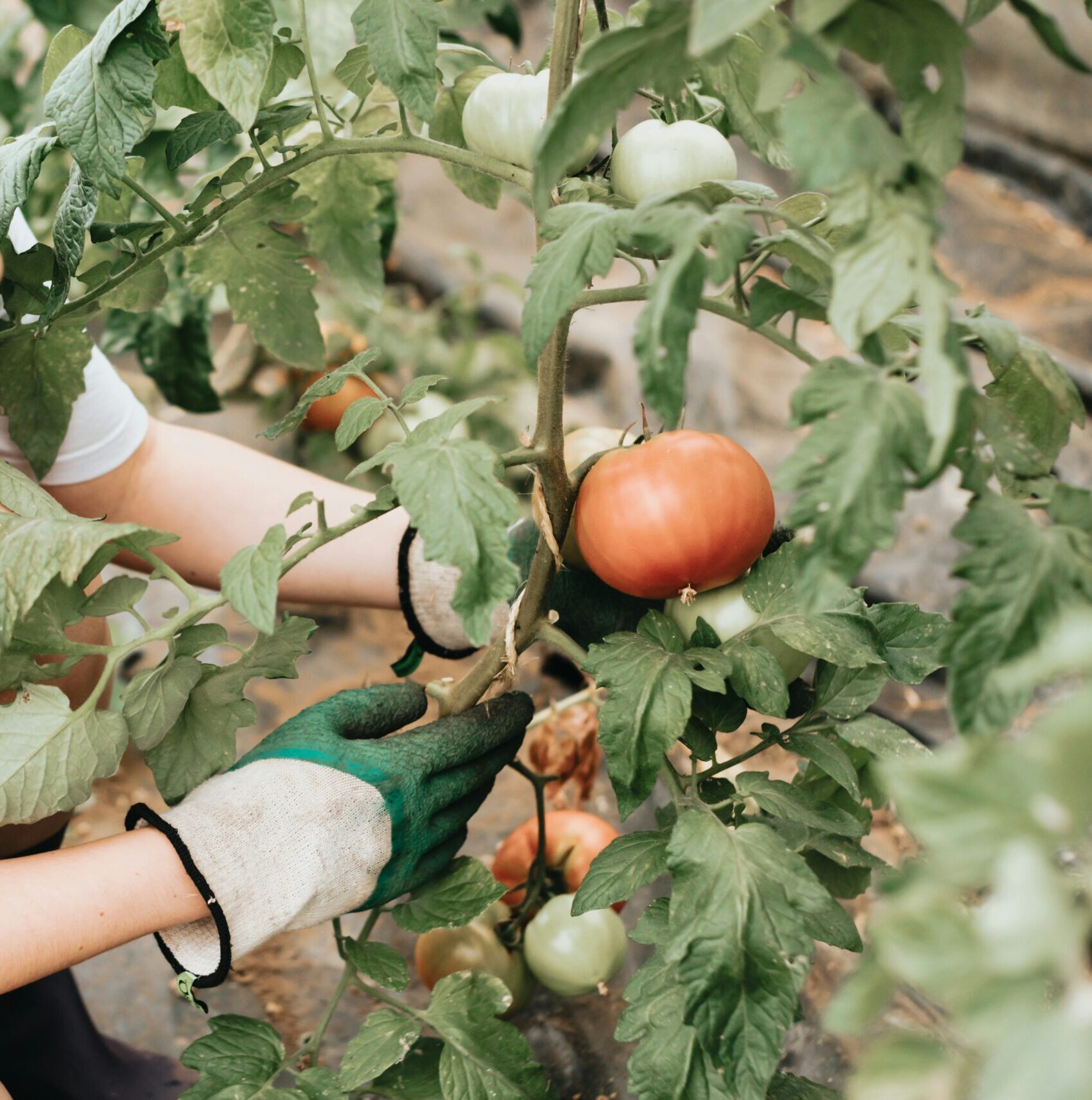I reach the grass and slip off my shoes, feeling the cool blades under my feet. It’s a short walk from my driveway to the back corner of my yard, and once I arrive I begin to gently pick every tomato from my garden and place them into my basket. Looking at my bounty, I sigh deeply with satisfaction.
I’ve done this same thing every afternoon for weeks, and I already feel a weight knowing the season will be over soon—the warm sun rhythmically hitting my face, the squishy walk to the backyard, the unexpected pops of bright red every day. When I began harvesting in August, it was a chore. By September, I’m desperate for it to continue. I know I can’t make the season stand still, but I wish I could feel as held and secure all the time as I have come to feel when picking tomatoes.
I entered that summer in a cloud of grief and fatigue. My second child was a fussy newborn and an impossible sleeper. At just over a year old, she was still struggling at night and leaving me unpredictably exhausted. Her older brother was eager for preschool, but our favorite option had fallen through and I was feeling like I’d failed him. I was on a break from the graduate program I had been investing my heart and time into for three years and unsure of what I should do next.
Long midwest days and fresh Lake Michigan water helped to soothe me, but nothing captured my attention like the tomatoes. My husband began to joke that I was channeling all of my anxiety into them—taking the energy that was once obsessed over my own slop of anger, burnout, and shame and instead, now putting it into my garden. I knew he was right. Instead of trying to solve my unsolvable problems, I tended seedlings and picked weeds.

But somehow it did not feel haphazard, even though there had been no careful intention-setting—just the obligation of red tomatoes on the vine. But with every day of tending and harvesting, I began to tread a path toward healing, and I submitted to the process. We had entered into a strange dance, the tomato plants and me, and their life, death, and offering was helping to carry my burdens.
With the tomatoes, I became a person who partnered with God in making things grow. I saw something I planted in a tray become food on my plate. I knew I had done none of it, really—the sun, water, nutritious earth, and sustenance of God took it from tiny seed to delightful fare. I was filled with enormous gratitude for every tomato I picked, overcome with almost a childish sense of delight: Today, more? Really, even more today? In this dance, my face turned from myself and toward God’s goodness.
It did not solve any of my problems. My grief did not disappear. My daughter slept just as unpredictably, and our second-choice preschool was not what we’d hoped it would be. But all of it fell into the vast, sacred expanse of God’s providence.
Like everything else between God and me, God started it. When my access to formal worship felt impossible, both because of personal baggage and the realities of parenting young children, God sought me in the tomatoes.
____
In Desiring the Kingdom, James K.A. Smith describes liturgies as “rituals of ultimate concern: rituals that are formative for identity, that inculcate particular visions of the good life, and do so in a way that means to trump other ritual formations.” Planting, watering, weeding, pruning, freezing, canning, processing, and composting—any gardener knows that these routines, or rituals as they are called by Smith, are simply a part of growing things. One cannot grow anything without doing some of the same things over and over again.
Rituals are ripe for becoming liturgies, if we let them. In my vulnerability and God’s ever-loving desire to care for me, my tomato-tending ritual turned into a liturgy, and the power of the liturgy shepherded me toward healing.
Smith says that liturgies “shape our identity.” Christian tradition sees liturgy as a specific form of worship and also a component of sacramental theology: liturgy not only pulls us toward the divine in worship, but it also takes ordinary things and makes them sacred.
In Exodus 16 God establishes one of the first liturgies. The Israelites are without food or water in the wilderness, so God sends manna to sustain them and prescribes a ritual: the Israelites must collect the manna over and over again, once in the morning and once at night (Exodus 16:12). In it, God both creates opportunities for worship and begins to shape the Israelites into a people. It’s a well-worn trick of God’s—worship, submission, and identity-building masked as harvesting food.
I once was with an Anglican seminarian who told me earnestly, “We need the liturgy.” My Reformed (Christian Reformed, specifically) upbringing was not particularly liturgical, and at the time I couldn’t understand what he meant. Now I know: God agrees with him, in a way far more expansive than the words on the page I’d read aloud when I’ve visited mass.
God knew I needed a reshaping of my identity, away from someone who failed the ones she loved and made decisions that failed her, and into a person who plays a part in the web of created goodness. God knew, too, that I needed my worship reoriented. The Bible says that in the absence of worship even the “stones will cry out” (Luke 19:40). Without a tidy opportunity for traditional worship, the tomatoes lifted my eyes toward God—an everyday object, sacramentally transformed.
I need the liturgy, and in my neglect of seeking it, it found me—not in words on a page or recitation in a church, but in planting, growing, weeding, harvesting, roasting, and eating—it found me in tomatoes.


4 Responses
LIke Jesus said: Fret not! Consider the tomatoes of the field….
What lovely words, Abigail. Thank you for this.
Mind and spirit expanding – gardening as liturgy. Thank you!
Yes, yes. Beautiful, Abby. I loved reading this, at least in part because I can put site, smell, and even taste to your liturgy, knowing right where your garden is. As is the case with your tomatoes, there is so much goodness in the ordinariness of life. Thanks be to God.